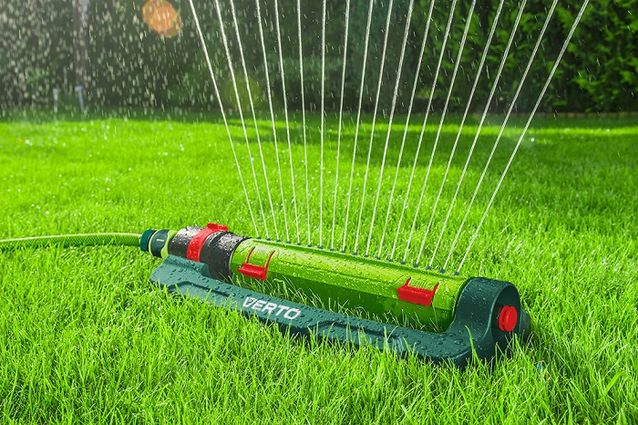Every owner of a plot of land or a home garden must face the challenge of regular watering. Proper watering is one of the basic steps to ensure that the plants grow lush and the lawn does not dry out and maintains a beautiful green colour. Mistakes and lack of knowledge about watering can lead to serious consequences, such as plant rotting and dying, so it is a good idea to start by learning how to water your garden properly and which watering system is best for your needs.

Good practices
Regardless of which green area you water and which watering style you decide on, it is worth remembering a few basic rules concerning proper watering of your plants.
One of the most important rules is to pick the right time of day. Most gardening guides suggest watering in the morning, especially when it is hot. In the morning, water soaks into the soil quicker, allowing the roots to absorb water more effectively. However, if you are not a morning person, you can water your garden in the evening when the air is cooler than during the day. Under no circumstances should you water your plants in the middle of the day during the summer time, as this can lead to severe burns to the plant’s structure and even its death.
What is more:
- It is better to water the garden less often but more plentifully, so that the water soaks into the soil to a depth of about 10-15 cm and reaches the lower parts of the roots. The exceptions are young, poorly rooted plants, where a lot of water is not recommended.
- The watering process should be carried out over a longer period of time using small, regular portions of water to ensure that soaking is slow and gradual. Flooding of the roots can lead to plant rotting and dying.
- Additional spraying of leaves is usually not recommended either – at night, fungi can accumulate on wet parts of the plant, and during the day moisture can lead to burning of the leaves.
Once you have become acquainted with all of the above rules, it is worth considering what method of watering is best for your garden.

Stationary watering
It is the kind of watering that might seem most convenient. In this method, watering involves a mechanical sprinkler, which distributes water itself, without human intervention. A big advantage of this irrigation system is the possibility to program the watering frequency, if you additionally install a tap timer. Such a functionality allows you to water your garden regularly, even during a long absence from home (e.g. during holidays). Stationary watering is best suited for even surfaces (e.g. large areas of grass). Traditional stationary garden sprinklers, such as the VERTO 15G785 Spike Sprinkler, allow for even watering of up to 78m2. An interesting option is also VERTO 15G773, which allows you to adjust the range and width of spray. It is equipped with a pressure adjustment knob that allows you to adjust the sprinkler to the area you want to irrigate. However, if you have a large lawn area of more than 100m2, it is worth considering buying a sector sprinkler, such as the VERTO 15G788 sprinkler with 6 functions that can irrigate up to 350m2. However, stationary watering is not always the best solution – in case of flower beds, plant clusters or hedges, it is better to choose manual watering.

Manual watering
This system is much better for spot watering (e.g. shrubs, trees) and irrigation of plants with irregular shapes (e.g. flower beds, hedges). The mechanism consists of a traditional garden hose, connected to a water source and ended with a spray gun. A big advantage of manual sprinklers is the possibility to adjust water pressure and type of jet. In modern systems, all these options are integrated in the spray gun. An example of such a sprinkler is our VERTO 15G710 model, which can be used to adjust the spray pattern by means of a knob located on the handle where the thumb is placed. In addition, clear figurative signs on the handset allow you to set the type of water jet and adjust it to the needs of your plants – for example, you can water delicate and young flowers with a mist, and use a pencil jet for trees and shrubs deeply rooted in the ground. With a strong water jet you can also wash away dirt from the pavement and paving stones, while a pressure reducing jet will help fill a bucket or watering can without splashing. The VERTO offer also includes complex sets such as 15G713, which includes a spray gun, two-material fittings and a tap connector – the user, when buying one product, gets all the parts needed to connect the manual sprinkler to the hose and water source.

How about two in one?
Most home gardens have a variety of different plants, from large grassy areas to complex flower beds.
If you own such a garden, you should consider investing in an extensive watering system, combining both manual and stationary systems. To create such an installation, you need a special separator at the water source, which will allow the water stream to be separated into several lines.
No matter which irrigation system you choose, you should also remember to store your garden hoses properly, so that they do not take up much space and do not get damaged by bending or entanglement. For this purpose, it is worth investing in a professional garden hose holder VERTO 15G790. The reel of the holder is very capacious – it holds about 45 m of 1/2” hose and similarly about 35 m of 5/8” hose and about 15 m of 3/4” hose.


